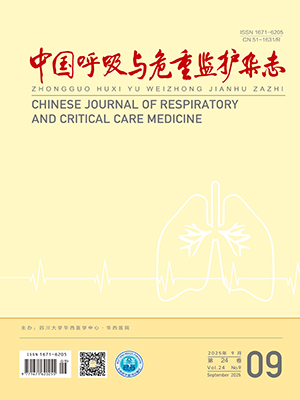| 1. |
李晓东, 李甜, 邸兴伟. 基于肺动脉压力导向的最佳呼气末正压对ARDS患者氧合指数及血流动力学的影响研究. 中国急救医学, 2020, 40(7): 619-623.
|
| 2. |
Banavasi H, Nguyen P, Osman H, et al. Management of ARDS - What works and what does not. Am J Med Sci, 2021, 362(1): 13-23.
|
| 3. |
Tonna JE, Peltan I, Brown SM, et al. Mechanical power and driving pressure as predictors of mortality among patients with ARDS. Intensive Care Med, 2020, 46(10): 1941-1943.
|
| 4. |
柳知含, 邸兴伟, 钟磊, 等. 自适应分钟通气+智能触发通气模式在轻中度急性呼吸窘迫综合征患者中的临床应用. 中华危重病急救医学, 2020, 32(1): 20-25.
|
| 5. |
ARDS Definition Task Force, Ranieri VM, Rubenfeld GD, Thompson BT, et al. Acute respiratory distress syndrome: the Berlin Definition. JAMA, 2012, 307(23): 2526-2533.
|
| 6. |
Peñuelas O, Frutos-Vivar F, Fernández C, et al. Characteristics and outcomes of ventilated patients according to time to liberation from mechanical ventilation. Am J Respir Crit Care Med, 2011, 184(4): 430-437.
|
| 7. |
Pensier J, de Jong A, Hajjej Z, et al. Effect of lung recruitment maneuver on oxygenation, physiological parameters and mortality in acute respiratory distress syndrome patients: a systematic review and meta-analysis. Intensive Care Med, 2019, 45(12): 1691-1702.
|
| 8. |
Schreiber AF, Ceriana P, Ambrosino N, et al. Physiotherapy and weaning from prolonged mechanical ventilation. Respir Care, 2019, 64(1): 17-25.
|
| 9. |
Maia LA, Samary CS, Oliveira MV, et al. Impact of different ventilation strategies on driving pressure, mechanical power, and biological markers during open abdominal surgery in rats. Anesth Analg, 2017, 125(4): 1364-1374.
|
| 10. |
李晓东, 李甜, 郝春艳, 等. 自适应支持通气+智能模式对老年慢阻肺合并呼吸衰竭患者呼吸力学的影响. 中国老年学杂志, 2020, 40(14): 2979-2981.
|
| 11. |
Arnal JM, Saoli M, Garnero A. Airway and transpulmonary driving pressures and mechanical powers selected by INTELLiVENT-ASV in passive, mechanically ventilated ICU patients. Heart Lung, 2020, 49(4): 427-434.
|
| 12. |
Becher T, Adelmeier A, Frerichs I, et al. Adaptive mechanical ventilation with automated minimization of mechanical power-a pilot randomized cross-over study. Crit Care, 2019, 23(1): 338.
|
| 13. |
谢永鹏, 钱颖, 刘克喜, 等. ARDS患者机械功与肺部超声评分的相关性以及二者对预后的评估价值. 中华危重病急救医学, 2019, 31(6): 704-708.
|
| 14. |
Spassov S, Wenzel C, Lozano-Zahonero S, et al. Sine ventilation in lung injury models: a new perspective for lung protective ventilation. Sci Rep, 2020, 10(1): 11690.
|
| 15. |
Beloncle F, Piquilloud L, Olivier PY, et al. Accuracy of P0.1 measurements performed by ICU ventilators: a bench study. Ann Intensive Care, 2019, 9(1): 104.
|
| 16. |
Albaiceta GM, Blanch L. Beyond volutrauma in ARDS: the critical role of lung tissue deformation. Crit Care, 2011, 15(2): 304.
|
| 17. |
Sato R, Hasegawa D, Hamahata NT, et al. The predictive value of airway occlusion pressure at 100 msec (P0.1) on successful weaning from mechanical ventilation:a systematic review and meta-analysis. J Crit Care, 2021, 63: 124-132.
|
| 18. |
Silva PL, Ball L, Rocco PRM, et al. Power to mechanical power to minimize ventilator-induced lung injury?. Intensive Care Med Exp, 2019, 7(Suppl 1): 38.
|
| 19. |
Akoumianaki E, Lyazidi A, Rey N, et al. Mechanical ventilation-induced reverse-triggered breaths: a frequently unrecognized form of neuromechanical coupling. Chest, 2013, 143(4): 927-938.
|
| 20. |
Goligher EC, Brochard LJ, Reid WD, et al. Diaphragmatic myotrauma: a mediator of prolonged ventilation and poor patient outcomes in acute respiratory failure. Lancet Respir Med, 2019, 7(1): 90-98.
|




